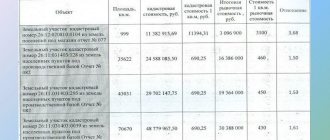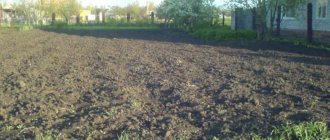Standard property registration scheme
- This is possible if the owner has the necessary documents ready and updating the existing data is not yet required. You must have a passport, confirmation of the right to a land plot (contracts of donation, purchase/sale, lease, documents on the right of inheritance, court decisions, etc.), a cadastral passport of the plot. A receipt confirming that the citizen has paid the state duty is also attached here.
- The next step is that the owner must write an application to Rosreestr. It includes a request for registration, information about a plot of land of a cadastral and boundary nature, and passport data of an individual.
- Rosreestr issues confirmation that the documents have been accepted and reviews them within 7-9 days. If there are no discrepancies in the documents (for example, between rights that arose earlier), a corresponding note is made in the Unified State Register of Real Estate.
EGRN is the primary owner of property information
Important! You can also register ownership as private in a multifunctional center. The registration operation here is absolutely identical to that which occurs in Rosreestr, and the data received by these organizations replenishes the unified information bank. In addition to personal contact, citizens can use the services of regular or e-mail.
Upon completion of all aspects related to the registration of property rights, the citizen receives a corresponding certificate of ownership.
The procedure for transferring rights in case of complete alienation
- The current and future owner enter into an agreement. It specifies the nuances of the transfer, the rights and obligations of each party, the conditions for the transfer of rights, the date and place of conclusion of the agreement and the date from which it comes into force.
- A detailed acceptance certificate is drawn up.
- The documents are transferred to Rosreestr. Along with this, a check for payment of the state fee for re-registration must be submitted.
Important: according to the law, if there is a house on a land plot registered as an individual housing construction project, it must be registered to the new owner at the same time as the land.
- The new owner takes his extract from the Unified State Register of Real Estate, indicating personal data and technical information about the site.
If the land is leased
- A long-term lease agreement is concluded. It must indicate a period of at least 1 year.
- Together with other documents for the land, the agreement is transferred to Rosreestr, where it is registered. From this moment on, an encumbrance is placed on the land for the period specified in the agreement.
If the land is alienated in favor of a relative
Re-registration of a land plot to a relative can be free if:
- a gift agreement has been drawn up;
- Close relatives participate in the transaction: parents and children, brothers and sisters.
In other cases, re-registration is subject to state duty.
How to pay state duty
The cost of the state duty varies depending on who pays it - an individual or a legal entity (hereinafter referred to as f/l and y/l), and the intended purpose of the allotment affects the price of the issue.
Minimum costs - 100 rubles - are expected for f/l and y/l, registering shares in common agricultural property.
350 rubles , whether an organization or an individual, will be spent when registering agricultural plots. For the same amount, land is registered for personal farming, building a garage, and planting a vegetable garden.
The price increases significantly for land plots with a house or a plot for individual housing construction: 2 thousand rubles for a f/l and 22 thousand rubles for a y/l.
If you pay electronically, it will be cheaper
The extract from the Unified State Register of Real Estate combines information from the Unified State Register of Rights Registration and the cadastral passport - it will cost 750 for a f/l and 2,200 rubles for a f/l if it is made on paper. In electronic form it is cheaper: 250 rubles f/l and 700 rubles u/l. An extract from the Unified State Register is necessary, as it makes it possible to obtain information about the real estate being registered before concluding a transaction to transfer the right to private ownership of land.
How to re-register a dacha?
The word “dacha” can mean both a house and a plot of land, or perhaps both. Over the years, legislation has allowed different ways of processing documents.
In 1992, land privatization began. Before this date, it was possible to transfer buildings from one person to another during their lifetime or by inheritance.
Now there are many court decisions recognizing ownership rights to non-residential houses, buildings, and land plots. Therefore, when we say “re-register a dacha,” we can mean the documentary transfer of exactly the property that is registered with the owner according to the documents.
And depending on the object, the process may be different.
Rewrite a privatized dacha? Land received on the basis of the Administration's Decree on free transfer of ownership is the property of the citizen in whose name it is registered (unless otherwise proven in court). Then the consent of the spouse is not necessary when alienating the land; you can re-register it only of your own free will.
Or, for example, re-register a share of a house received by inheritance. The rules are similar here.
But if the dacha was purchased during marriage, the consent of the second spouse is required. If a house is built on a privatized plot of land during marriage, the consent of the other half will also be required to alienate the house.
Sell or donate a non-privatized dacha? It can be done. Options for re-registration depend on the state of the documentation of the SNT itself, the understanding of land legislation issues by the board, and, of course, only in the absence of disputes with adjacent land users.
Although, if there are disputes, they can be settled in advance and then re-registered. Our lawyers will help you do this.
Register an allotment for only 350 rubles
It is possible to do without extra costs, but this only applies to a rather narrow range of cases. A common option that citizens apply to when registering land ownership, when there is a certificate of the right to lifelong inheritable and permanent ownership of land (PNV). It is not enough to complete a purchase and sale transaction. It is necessary to register ownership according to the new laws.
Registration of land ownership is not always expensive
The big advantage of this case is that land surveying is not necessary here, and, consequently, costs are significantly reduced: the approximate cost of the necessary land surveying work ranges on average from 10 to 30 thousand rubles . Therefore, the question of how much it costs to register a plot of land will not frighten the owner with large numbers.
See also: Catalog of the most popular plots in the Moscow region intended for the construction of suburban real estate.
What organizations provide assistance in decorating a dacha?
Help of this nature can be provided by firms specializing in various legal services, and you can also try to contact real estate agencies that have positively established themselves in the market for such services. The cost of full support of this transaction will cost around 25 thousand.
rubles, but it all depends on the volume and complexity of the order.
To do this, you can go to their website and order a free call with a consultant or personally contact their office.
Re-registration of ownership of a real estate property to another owner may not cost a lot of money if the current owner was responsible in obtaining all the documents necessary for this, and in terms of time spent, you can save a lot.
Fast, cheap and legal. We know how to do this, contact us, call us!
- purchase and sale or donation agreement - from 2.8 thousand rubles.
- “safe transaction” with cash payments - from 10 thousand rubles.
- boundary, cadastral works - 10 (wholesale) -15 thousand rubles;
If the plot is inherited
Registration of inherited land costs 0.3% of the price of the plot - this applies to immediate relatives and 0.6% - for other persons. The notary issues a certificate of private ownership. The work of a notary will cost 5 thousand rubles . The declared amount will increase if the right to inheritance has to be defended in court.
It should be remembered that the object is recognized as real estate, and therefore it is necessary to register the allotment. To do this, you need to submit an application for state registration and provide a certificate received from a notary in addition to the standard list of documents. The state duty will be 350 rubles , for shared ownership - 100 rubles . State registration takes place within ten working days. Only after this the heir has the right of ownership to the acquired area.
State registration is one of the last stages
How to re-register a dacha after death?
When the owner passes away, an inheritance case is opened and it is necessary to collect and prepare documents. An application for inheritance for a dacha (house and/or land plot) must be submitted no later than 6 months from the date of death of the testator.
- Notarial procedure;
- A legal dispute (in which the defendants will be either government agencies or other heirs or owners laying claim to the property).
You can get advice on this case for a fee or free of charge at an appointment with our specialists.
The land was received under a gift agreement
As in previous options, ownership of the donated plot arises when the title to the land is registered with the state registration service. There is no need to register the contract itself and pay a state fee for it. Rosreestr registers the submitted documents, finds out whether the transaction is legal, and conducts a legal examination. The papers are assessed for the presence of contradictions between the rights to the object that already exist and those newly declared. When the owner receives a state registration certificate, it is difficult to challenge his rights; this is only possible by going to court.
The recipient is required to pay tax on the property received. It includes 13% of the cost of the plot if you are a resident of the state and 30% when you are not. The donor's immediate family is not required to pay tax. The owner, having received the plot, in order to avoid a fine of 1 thousand rubles , must submit a 3-NDFL declaration, indicating the cost of the plot.
The donation must also be formalized in accordance with the law.
The procedure for transferring land rights
To transfer ownership, you can make one of the types of civil transactions. Conditions for this:
- the cadastral chamber must contain information about the alienated land plot;
- Regardless of whether the transaction is planned for compensation or gratuitously, the agreement on it is registered in Rosreestr. Only from the moment of registration and the appearance of information in the cadastre about the new owner, the rights to the object are considered transferred;
- the lease agreement will be registered in Rosreestr only if the lease relationship is of a long-term nature - at least a year;
- any transaction must be a voluntary decision of the owner. This principle is enshrined in his personal signature in all documents.
When do you need a cadastral engineer?
Geodetic organizations carry out work on the ground and draw up a boundary plan for the site. It is required:
- if there is no record in the cadastral chamber;
- before any transaction, if the boundary plan has not been prepared earlier;
- during demarcation;
- in case of disputes and questions regarding the boundaries of the site.
The cadastral engineer carries out geodetic work in the presence of the following persons:
- the owner, long-term tenant or authorized person if there is a notarized power of attorney for the plot itself;
- the same persons representing neighboring areas bordering the study area;
- representative of the municipality, if necessary.
The result of the work is a boundary plan. He contains:
- technical information about the land plot;
- drawing-plan of the area;
- signatures of all those present. In this way, all owners confirm their agreement with the measurements and certain boundaries. If there is no signature, there must be an explanation (for example, notification of delivery of a registered letter with an invitation to attend the land survey). It can be extremely difficult to transfer the right to a plot without the necessary signatures on the boundary plan.
Buying or selling a plot
Ownership rights may arise as a result of a purchase and sale transaction and the execution of a corresponding agreement. Such an agreement, according to current legislation, must be registered. You can resort to the services of a notary, and he will assure that the transaction was carried out legally, or contact Rosreestr or the MFC. Registration of the agreement in the Unified State Register of Real Estate makes it possible to use the land and make transactions with it. Registration of the contract and the right to property (do not confuse these concepts) can be completed online on the Rosreestr website or through the State Services portal.
The Tax Code, Art. 33: the fee will be 2 thousand rubles if no buildings were erected on the site; Registration of land with a house is estimated twice as much.
It is possible to register the right to land during purchase and sale by preparing an extended package of documents. To the usual set (passport, cadastral and survey documentation), an excerpt from the Unified State Register from the seller, powers of attorney from the seller and buyer, pre-certified, a certificate of ownership, the consent of the owners to sell the share and the consent of the spouse, a purchase and sale agreement (will be required) is added 3 copies), application for state registration, transfer document under the contract, payment of state duty certified by a receipt.
Each document is made in the required number of copies
Grounds for re-registration
You can re-register ownership of yourself upon purchase, as well as register a land plot as your property solely on the basis of the existing right of use:
- Lifetime inheritable ownership.
- Permanent (unlimited) use.
This procedure means changing the design. Differing from the registration process, which can only concern the initial establishment of the legal status of a land plot “from scratch” to the full result, re-registration is based on existing stages. These include the forms of use of the site listed above.
That is, when registering land upon purchase, you contact the administration to provide a plot of land in your favor on the right of ownership, which is currently under its jurisdiction (possession). And when re-registering, you request permission to change the type of right. In this case, you are registering a new status of right in addition to the existing right of use in relation to your site.
In general, the re-registration of rights has the following types:
- Re-registration of the existing right to a plot by re-registration.
- Administrative procedure for recognition of rights.
- Civil legal process of re-registration.
- Recognition of property by filing a claim.
In some cases, the type of right to an existing plot is not indicated in title documents received before the introduction of the new Land Code.
In accordance with Article 36 of the Land Code of the Russian Federation, if the document does not indicate the type of right, or it is not possible to determine its status, ownership of the specified plot is determined as a property right. You can re-register the right to certifying documents through re-registration of the site at the regional department of cadastre and cartography. How to register a land plot as property by inheritance - read here.
When the certificate of title expressly states that ownership of the plot is carried out on the basis of permanent use or lifelong possession , recognition of the right is established in the administrative regime.
If you re-register your existing rights of use, the deadlines will be shorter and the financial costs will be less ruinous. That is, you will receive certain advantages. These include:
- Re-registration based on privatization (free of charge).
- Redemption at cadastral value.
The redemption process has the characteristics of civil legal relations in the re-registration of land. It is practically the only opportunity (with rare exceptions) to acquire ownership rights when registering land. The main difference lies in the established cost of the site:
- When re-registering, the redemption amount should not be set higher than the cadastral value of the plot.
- When registering, the market value is usually established.
A court decision must be resorted to in cases where:
- The title documents have been lost.
- The recognition of rights in administrative proceedings was not carried out for certain reasons.
A positive court ruling has legal force equal to an administrative act recognizing a right. Typically, a positive court decision is granted when the owner of an existing capital building claims to re-register the site under the house he built free of charge. What forms and types of ownership of land exist - read here.
Leased plot
While the plot planned for registration as private property, in accordance with the new legislation, appears as being leased, transactions are not available for the leaseholder, because the plot officially belongs to the municipality. To register a plot as personal property, an application is written to the local municipality, and cadastral documents must be ready, payment for the purchase of the plot and state duty must be paid.
Important! Poor citizens have the right not to pay for the redemption of land.
It is possible to register ownership of leased lands if there is privatized property on them, the site was used for agricultural work or for its intended purpose.
Grounds for alienation of property
Citizens who own a piece of land, but are not the owner, can restore rights to the property by contacting the local municipality. The petition is accepted if ownership of the plot occurs on the basis of:
1. unlimited use of the site;
2. lease of land from the local administration;
3. inheritance.
Documentation confirming the fact that the municipality has allocated land for personal use does not have a statute of limitations. It is provided to the district or city administration along with the application and other documents.
Also, the basis for re-registration of a garden plot is a court ruling. It is issued if the re-registration of a piece of real estate is carried out on the basis of inheritance, but the owner missed the deadline for entering into inheritance.
Legalize a plot in SNT
The law on dacha amnesty, which appeared in 2006, and the articles of the Land Code of the Russian Federation, in force since 2015, significantly facilitate the process of registering territories for dacha ownership.
Thanks to the simplified system, ownership of land in gardening partnerships is transferred to individuals free of charge. The land at the dacha can be privatized or, under certain conditions - indefinite use, lifelong inheritance, lease agreement - purchased.
The dacha amnesty has simplified life for many
Plots that are not officially registered by the owner at a certain time and properly may pass to the state. Registration of a cadastral passport and paid state duty allow you to carry out activities for state registration of rights to a land plot. The limitation is this: the land must be assigned to the cooperative no later than October 30, 2001, and the dacha plot must be free of encumbrances. Of course, you will need papers that can confirm the right to property.
Restrictions on the sale of land plots
Re-registration of a summer cottage plot to another person is impossible in the following cases:
- there is an encumbrance on the land plot (pledge, alienation, court order);
- there is no land survey and cadastral number;
- the land is the subject of disputes or is owned by several persons.
When concluding a transaction, the owner of the land is obliged to provide complete information about the alienated plot and the restrictions applicable to it. If information is withheld, the transaction will be declared invalid.
If you need to register the land under the house
In this situation, until the house and the plot itself are privatized, the property is considered illegally used, and transactions with it are impossible. When there are cadastral documents for a house, the owners may mistakenly believe that this is enough and do not care about registering the land directly under the house, but it is an integral part of the residential building (apartment). In order to have a cadastral number and a passport for the land, it is necessary to organize geodetic work, which includes topographic survey, measurement with land surveying, as well as clarification of the boundaries with neighbors' plots.
Based on these data, the private individual receives a technical extract, takes the documents to the cadastral organization, and attaches as confirmation a receipt confirming that the state duty has been paid. As a result, a certificate is issued confirming the owner’s right.
Certificate of Title Cap
Re-registration procedure - where to apply and what to do
In order for the house and the area around it to acquire a new owner, it is necessary to find out where to go for re-registration and the procedure for the procedure itself.
- First, clarify the possible nuances of the procedure, how neighbors register their plots. Interview the owners of nearby plots; surely someone has had experience with the registration.
- Before re-registration it is necessary to carry out land surveying for the area. This is a geodetic procedure that helps a specialist determine the plot size and mark the boundaries. The results are then reflected on the document. The result is agreed upon with the neighbors, with whom the future owner has a common border.
- Get the original cadastral passport. There, in addition to the number assigned to the site, a detailed plan of the site is indicated, the boundaries are described (their coordinates, the distance of all buildings).
- Receive circulars for all buildings actually located on the site (house, barn, work premises, bathhouse). To do this, visit the BTI. The future owner leaves an application there, according to which experts will come out. They will measure and study the buildings, then enter the results into the technical and cadastral passports of all objects.
- Collect accumulated circulars. You may have to include a gardener's book there, although this is your private internal document. Often the registration procedure is a joint effort, when the new owner is helped by a partnership.
- Submit all received circulars to Rosreestr (at the same time, you must pay a fee and attach a receipt to the submitted papers).
If the materials are all prepared according to the standards and there are no problems, the verification and re-registration procedure will take only 10 days. Then the new owner is given a certificate confirming his rights with an extract from the registry. The certificate secures the rights to use the land.
Land acquired by squatting
When there are no papers for real estate, such an allotment is classified as obtained by self-capture. Any actions in such territories are illegal and subject to administrative liability. But there are ways that will help legalize these lands, making them private property.
A private individual needs to complete a purchase and sale transaction. When the land belongs to SNT or municipal authorities, it is necessary to submit an application to purchase the property. In circumstances in which the plot is the property of the state, it can be put up for auction (previously, the citizen contacts the authorized organization with a message about the desire to obtain the land into private ownership).
Purchasing at an auction makes it possible to register the ownership of land according to the scheme already discussed.
Useful information on land disputes
Moscow, Kievsky Station Square, 2 8 Free hotline
Everyone in life will have to deal with real estate issues. The desire to buy a summer house or maintain your own garden is quite common.
In this case, we will consider the issue related to dacha cooperatives. How to re-register a summer cottage? Is it important to use the services of a lawyer? What documents are needed to re-register a summer cottage? Where should I contact? How much does it cost to redecorate your dacha? These and other questions will be discussed in detail in this article.
Existing restrictions
The state has applied a number of restrictions that do not allow specific territories to be registered as property. These include
- territories of cemeteries and parks;
- lands of state reserves and armed forces;
- nuclear power facilities;
- lands withdrawn from circulation.
You can't build a house everywhere
Required documents
To re-register a site, you need to prepare a package of documents:
- identification documents of the parties to the transaction;
- if the interests of one of the parties are represented by an intermediary, a notarized power of attorney is required;
- documentation confirming the transaction;
- cadastral passport of the plot and a duplicate of the cadastral plan;
- receipt of payment of state duty;
- documentation of acceptance and transfer signed by the parties to the transaction (not required for inheritance).
The size of the state duty is the same for all regions and is 2 thousand rubles.
Briefly about the main thing
The law on dacha amnesty, which appeared in 2006, and the articles of the Land Code of the Russian Federation, in force since 2015, significantly facilitate the process of registering territories for dacha ownership. The law on dacha amnesty, which appeared in 2006, and the articles of the Land Code of the Russian Federation, in force since 2015, significantly facilitate the process of registering territories for dacha ownership. The law on dacha amnesty, which appeared in 2006, and the articles of the Land Code of the Russian Federation, in force since 2015, significantly facilitate the process of registering territories for dacha ownership.
| A little more attention! Write in the comments what you think - does such bureaucracy simplify the life of the average citizen or is it done more for the convenience of public services? |
Ratings 0
Read later
What are the ways to re-register a dacha?
There are several ways to re-register a dacha to another owner:
- Draw up a purchase and sale agreement . This will be one of the most expensive options.
- Draw up a gift agreement . This method is best chosen if the future owner of the dacha is your close relative (parents, grandparents, brothers and sisters). The costs here will be minimal.
- Pass on by inheritance . This is also an expensive re-registration option. The most important thing is to enter into inheritance on time.
It is worth remembering that if the owner has a document on the right of ownership of this real estate property, it will significantly facilitate the registration of the dacha as the property of another person, and therefore will be less expensive.
Re-registration of a private house as your own property
A private house is re-registered in one’s own name in order to obtain a certificate of ownership.
Previously, all transactions with real estate, namely with private houses, were carried out only by notaries. Now, you just need to issue a certificate, and then you can dispose of the house at your own discretion, based on the certificate of title. Otherwise, without it, not a single transaction involving this real estate can be carried out.
In order to register ownership of a house, you need to collect a package of documents, exactly the same as in the first case described above.
The package of documents will be approximately the same, except for those documents that related to the person to whom the property was re-registered.
When preparing a package of documents, you must know the following:
— If you do not have a cadastral passport, you need to contact the BTI authority with a ready-made application for the production of a package of new cadastral documents.
The application will need to be accompanied by a copy of your passport and a receipt for payment of the state fee.
A visit from a BTI specialist is scheduled to take the necessary measurements for these documents.
These documents must be familiarized to everyone registered in the house, if any.
Based on the measurements, new cadastral documents are produced; the production period is 14 days.
When the entire package of documents has been collected, you need to submit them to the MFC or Rosreestr.
When submitting documents for state registration, a date will be set to receive an already certified contract.
One of the parties to the transaction can pick up the completed documents.
After 12 days, the property certificate will be ready.
If the completed documents are not collected on time, the MFC stores them for exactly a month, after which they are sent for storage to the city archive.
It is important not to forget that when documents are submitted to the MFC, you must take a receipt from the employee who accepted the package of documents.
- I bought a house with a receipt. What should I do to re-register documents in my name?
- What documents are needed to re-register a house in the name of a daughter?
- What documents are needed to re-register the house from my husband to me? Thank you.
- What documents are needed to re-register a house? There is a deed of gift.
- What documents are needed to re-register a deed of gift for a part of the house?
- Re-registration of documents
- Home renovation
- House without documents
- Preparation of documents at home
- Registration of documents for the house
Features of re-registration of a property
There are two ways to re-register a plot of land: to buy it from the legal owner or to register the right with Rosreestr. Only the owner can transfer ownership of a plot.
Re-registration is carried out at the local unit of the Cadastral Bureau. If the property does not undergo re-registration, the municipality may question the legality of ownership of the site.
IMPORTANT! If there is a garden house on the site, you must first register the ownership of the building.
What documents are needed at the very beginning of registration of ownership?
Legally, a dacha consists of two pieces of real estate: a plot of land and a building on it. For example, outbuildings can be added: greenhouses, bathhouses, garages. It is important that each property is a separate unit of real estate, receives an individual cadastral number and is registered separately.











